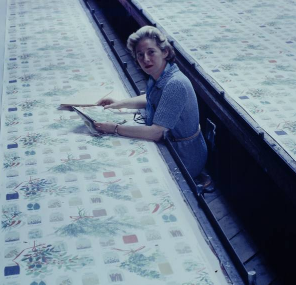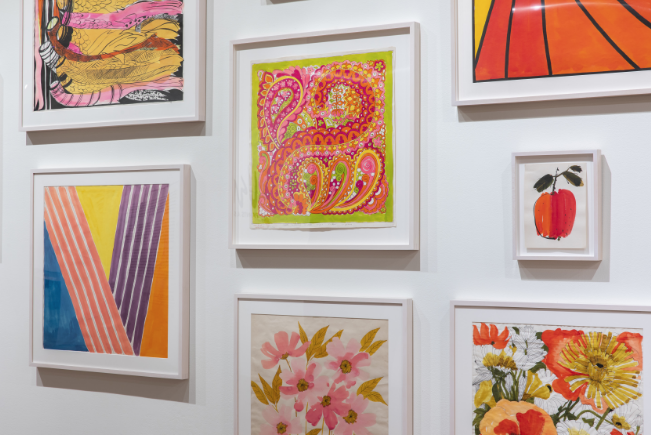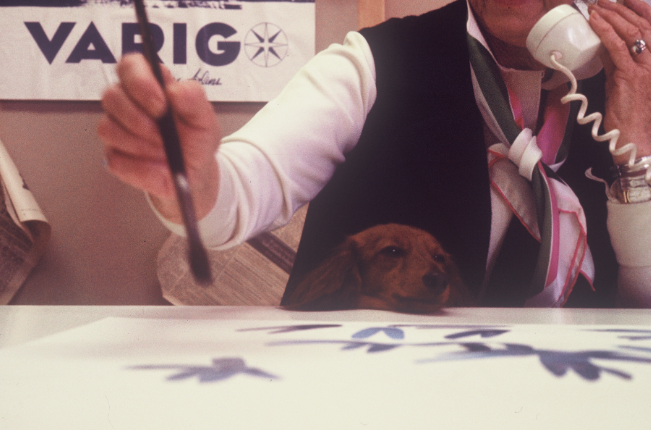
by Yona Zeldis McDonough
“Vera Paints a Scarf”- Honoring the Life and Designs of Vera Neumann
For Proust, a tea-soaked madeleine was the portal to memory, but for me it was the show “Vera Paints a Scarf” at Manhattan’s Museum of Art and Design. The show celebrates not only the scarves but also the tableware, clothing, posters, stationery, and paintings created by the eponymous designer. Back then, I didn’t even think to associate the name, scrawled in loose, jaunty script, with an actual person. It seemed like the name of a product, only slightly more resonant than Kleenex or Mattel, though I did like the little ladybug (more on that later) that was part of the logo.
Instead, I was captivated by the bright colors, the breezy, slightly insouciant style, the sheer joy of the designs, which were easy mix of natural elements like trees, flowers—lots of flowers—birds, insects (that ladybug again) fruits, and vegetables, along with more abstract patterns, some sinuous and lyrical like her paisleys, others more geometric or linear. Of the ladybug she said that it “means good luck in every language.” Both her palette and her aesthetic felt fresh and distinctly modern, the shifts and tunics designed for girls like me, or maybe the girl I aspired to be—think 1960s model Twiggy in one of those little dresses and a pair of go-go boots and you get the idea.
I don’t know how or when I lost track of Vera, though I do recall occasionally encountering the scarves in my perpetual second-hand-shmatte hunt, when such a discovery would be accompanied by a whiff of nostalgia and even melancholy. So walking into the show at MAD was a thrill that brought it all rushing back—color, the whimsy, the echo of the girl I was when I first discovered her.

MAD Museum
But as I reconnected with the patterns and designs I had loved so much, I also learned so much about Vera the person, not just Vera the brand. She was an artist, an entrepreneur, a tastemaker and a branding/marketing genius at a moment when the expectations of most women never veered far from marriage, children and home. Vera wasn’t just ahead of her time; in a sense, she was the creator of a new time, one that ushered in such like-minded giants as Martha Stewart and Tory Burch.
Vera was born in Stamford, CT in 1907, the third of Fanny and Meyer Salaff’s four children, and she was named for the author of the book her mother was reading while pregnant with her—Vera Bashkirtseff. The Salaffs were Russian Jewish immigrants, and uncommonly supportive of their children’s creativity. Little Vera spent a lot of time outside, fascinated by nature, and also by rendering it. Her father gave her 50 cents for each sketchbook she could fill with her doodles. He also hired a sign painter to give her art classes and took her to the Metropolitan Museum of Art every Sunday. After graduating from high school, she attended attended The Cooper Union for the Advancement of Science and Art and enrolled in classes at the Traphagen School of Design after graduation. Her first job was as a fashion illustrator and then a textile designer on Seventh Avenue in New York. Shortly afterwards, she left to design fabric and murals for children’s rooms.
Vera met and married Austrian George Neumann, who was from a family whose background was in textiles. The couple moved into a small studio, where they decided to merge their professional lives by forming a company called Printex. They built a small silkscreen printing press to fit on their dining room table—which was only large enough for them to produce linen placemats, which were then cured in their kitchen oven.
The Neumanns were soon joined by their friend Frederick Werner Hamm, a recent German immigrant, and another textile maven. Hamm used his sales skills to secure their first order from the late (and-sorely-missed B. Altman department store). When the company outgrew the small apartment they moved into a larger one. When they outgrew that, they decamped to Ossining, NY, where they took possession of a large—and derelict—1810 Georgian mansion near the Hudson River.

MAD Museum
During World War II, Vera found linen supplies hard to get, so she went in search of alternatives. The discovery of several bolts of parachute silk at an army surplus store led to an aha moment, and the beginning of her scarf business. She kept her signature on art transferred to the scarves, thus creating the first signature scarf in history. “Vera scarves” became popular immediately. Marilyn Monroe was as fan (and MM holds a Vera scarf over her breasts in one of the famous images from Bert Stern’s series “The Last Sitting”). So were Grace Kelly and first lady Bess Truman, who selected Vera fabric from Schumacher, Inc., to decorate the third-floor solarium windows and upholstery of the White House.
Vera liked to say that much of her success was due to luck, and to having been at the right place at right time. She could have also mentioned that the men in her life were uncommonly supportive, starting with her father, who nurtured her artistic longings, and her husband, who saw her as an equal and a partner.
In 1962, George Neumann died suddenly of a heart attack. Yet Vera’s business remained robust. By 1966, her scarves could be found in 10,000 stores in North America alone. Annual sales totaled $12 million. In 1967, Vera and Werner Hamm, who had remained on board, sold the company to Manhattan Industries. Both Vera and Hamm became board members, and Vera stayed on as creative director. The company expanded into sportswear, as well as luggage.

MAD Museum
Artistic acclaim soon followed. Emile Walter Galleries launched an exhibition in 1970. It included around 50 original paintings and drew art collectors from around the country; the first buyer was John Lennon. The Smithsonian inducted Vera into its Resident Associate Program in October 1972 as their first artist and commissioned her to paint the Foucault Pendulum, which still hangs in their offices today. The Institute launched “A Salute to Vera: the Renaissance Woman” at the Museum of History and Technology. In 1975 the Fashion Institute of Technology’s Museum launched a retrospective, “Vera: The Artist in Industry 1945–1975” and the Goldie Paley Design Center at the Philadelphia College of Textiles and Science opened a retrospective of their own in 1980 entitled “Celebrate the Seasons of the Sun With Vera.”
Vera remained in Ossining for the rest of her life, and died in 1993, at the age of 84. Attention to her work continued in the form of “Vera Paints a Rainbow,” a show installed at the Alexander Gray Associates in 2015.
The current show at MAD makes apparent Vera’s uncanny ability to fuse art with commerce. She was a working artist, continuing to seek inspiration in new places, yet she clearly wanted her creations to have a practical application in the lives of women. And strolling through these galleries, soaking up the undimmed light of her output, it’s clear just how brilliantly she succeeded.

MAD Museum
Yona Zeldis McDonough is the Fiction Editor at Lilith and the award-winning author of eight novels and twenty-eight books for children. She is also the editor of two essay collections and her short fiction, essays and articles have appeared in numerous national and literary magazines. Visit her at www.yonazeldismcdonough.com or www.facebook.com/yzmcdonough.